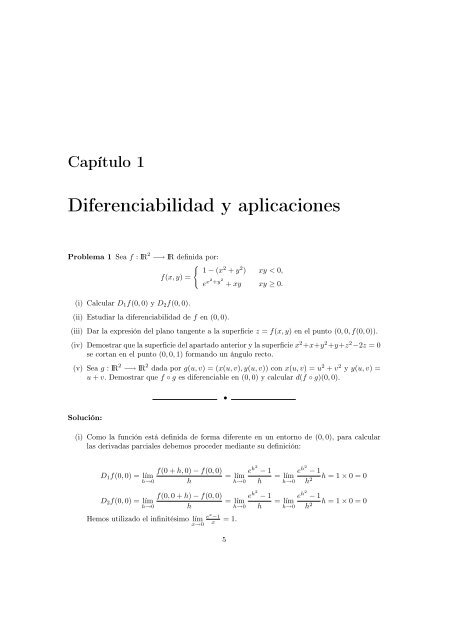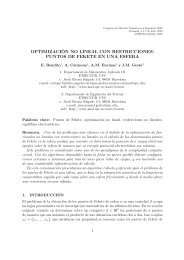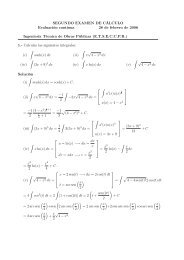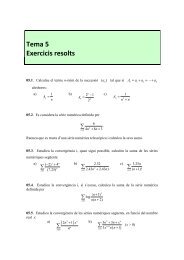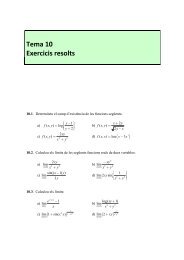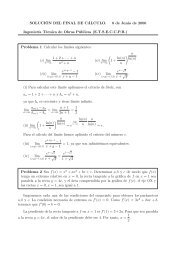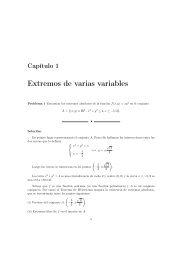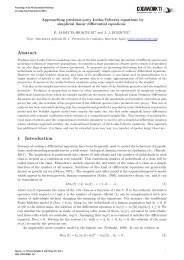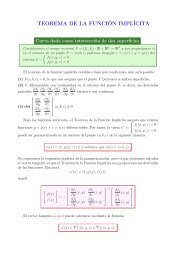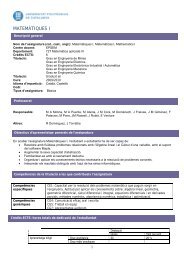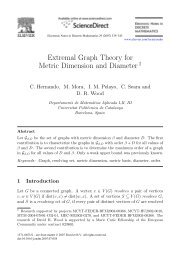Problemas de diferenciabilidad y geométricos
Problemas de diferenciabilidad y geométricos
Problemas de diferenciabilidad y geométricos
You also want an ePaper? Increase the reach of your titles
YUMPU automatically turns print PDFs into web optimized ePapers that Google loves.
Capítulo 1<br />
Diferenciabilidad y aplicaciones<br />
Problema 1 Sea f : IR 2 −→ IR <strong>de</strong>finida por:<br />
{<br />
1 − (x 2 + y 2 ) xy < 0,<br />
f(x, y) =<br />
e x2 +y 2 + xy xy ≥ 0.<br />
(i) Calcular D 1 f(0, 0) y D 2 f(0, 0).<br />
(ii) Estudiar la <strong>diferenciabilidad</strong> <strong>de</strong> f en (0, 0).<br />
(iii) Dar la expresión <strong>de</strong>l plano tangente a la superficie z = f(x, y) en el punto (0, 0, f(0, 0)).<br />
(iv) Demostrar que la superficie <strong>de</strong>l apartado anterior y la superficie x 2 +x+y 2 +y+z 2 −2z = 0<br />
se cortan en el punto (0, 0, 1) formando un ángulo recto.<br />
(v) Sea g : IR 2 −→ IR 2 dada por g(u, v) = (x(u, v), y(u, v)) con x(u, v) = u 2 + v 2 y y(u, v) =<br />
u + v. Demostrar que f ◦ g es diferenciable en (0, 0) y calcular d(f ◦ g)(0, 0).<br />
Solución:<br />
•<br />
(i) Como la función está <strong>de</strong>finida <strong>de</strong> forma diferente en un entorno <strong>de</strong> (0, 0), para calcular<br />
las <strong>de</strong>rivadas parciales <strong>de</strong>bemos proce<strong>de</strong>r mediante su <strong>de</strong>finición:<br />
f(0 + h, 0) − f(0, 0) e h2 − 1 e h2 − 1<br />
D 1 f(0, 0) = lím<br />
= lím = lím<br />
h→0 h<br />
h→0 h h→0 h 2 h = 1 × 0 = 0<br />
f(0, 0 + h) − f(0, 0) e h2 − 1 e h2 − 1<br />
D 2 f(0, 0) = lím<br />
= lím = lím<br />
h→0 h<br />
h→0 h h→0 h 2 h = 1 × 0 = 0<br />
Hemos utilizado el infinitésimo lím<br />
x→0<br />
e x −1<br />
x<br />
= 1.<br />
5
6 Índice general<br />
(ii) Si f es diferenciable en (0, 0), entonces df(0, 0) = (0 0) (candidato a diferencial). Para<br />
<strong>de</strong>mostrar que efectivamente f es diferenciable <strong>de</strong>bemos calcular el siguiente límite y<br />
comprobar que da cero:<br />
)<br />
lím<br />
(h,k)→(0,0)<br />
f(0 + h, 0 + k) − f(0, 0) − df(0, 0) ( 0<br />
0<br />
√ = 0<br />
h2 + k 2<br />
El valor <strong>de</strong>l límite anterior <strong>de</strong>pen<strong>de</strong> <strong>de</strong> si nos acercamos a (0, 0) por puntos tales que<br />
hk < 0 o hk ≥ 0, por tanto <strong>de</strong>bemos realizar límites según subconjuntos.<br />
lím<br />
(h,k)→(0,0)<br />
hk
Índice general 7<br />
Problema 2 (i) Dar la expresión <strong>de</strong>l plano tangente a la superficie S ≡ x + y + y 3 (x 2 + 1) +<br />
z 2 = 1 en el punto (0, 0, −1).<br />
(ii) Sea α(t) = (t + 1, (t + 1) 2 ), t ∈ IR. Calcular la variación <strong>de</strong> g(x, y) = y 3 (x 2 + 1) a lo largo<br />
<strong>de</strong> la curva α en el punto (1, 1).<br />
•<br />
Solución:<br />
(i) La superficie está dada <strong>de</strong> forma implícita por f(x, y, z) = x + y + y 3 (x 2 + 1) + z 2 = 1,<br />
por tanto el plano tangente en el punto (0, 0, −1) es:<br />
Por otro lado,<br />
〈∇f(0, 0, −1), (x − 0, y − 0, z + 1)〉 = 0.<br />
∇f(x, y, z) = (1 + 2y 3 x, 1 + 3y 2 (x 2 + 1), 2z) =⇒ ∇f(0, 0, −1) = (1, 1, −2).<br />
Finalmente, la ecuación <strong>de</strong>l plano tangente es x + y − 2z = 2.<br />
(ii) Calculamos el vector tangente a la curva en el punto t = 0, ya que α(0) = (1, 1) y el<br />
gradiente <strong>de</strong> g en el (1,1).<br />
α ′ (t) = (1, 2(t + 1)) =⇒ α ′ (0) = (1, 2).<br />
∇g(x, y) = (2y 3 x, 3y 2 (x 2 + 1)) =⇒ ∇g(1, 1) = (2, 6).<br />
Finalmente,<br />
D α ′ (0)g(1, 1) = 〈∇g(1, 1), α ′ (0)〉 = 〈(2, 6), (1, 2)〉 = 14.<br />
Problema 3 Sea f : IR 2 −→ IR <strong>de</strong>finida por:<br />
⎧<br />
⎨ x sin(xy)<br />
√ (x, y) ≠ (0, 0),<br />
f(x, y) = x2 + y<br />
⎩<br />
2 0 (x, y) = (0, 0).<br />
(i) Estudiar la <strong>diferenciabilidad</strong> <strong>de</strong> f en IR 2 y hallar el gradiente <strong>de</strong> f para todo (x, y) ∈ IR 2 .<br />
(ii) Hallar la <strong>de</strong>rivada direccional <strong>de</strong> f según el vector tangente a la curva α(t) = ( √ t,<br />
en el punto ( √ π, √ π).<br />
(iii) Dar la expresión <strong>de</strong>l plano tangente a la superficie z = f(x, y) en el punto ( √ π, √ π).<br />
t<br />
√ π<br />
)<br />
•<br />
Solución:
8 Índice general<br />
(i) Como la función está <strong>de</strong>finida <strong>de</strong> forma diferente en un entorno <strong>de</strong> (0, 0), para calcular<br />
las <strong>de</strong>rivadas parciales <strong>de</strong>bemos proce<strong>de</strong>r mediante su <strong>de</strong>finición:<br />
f(0 + h, 0) − f(0, 0) 0<br />
D 1 f(0, 0) = lím<br />
= lím<br />
h→0 h<br />
h→0 h = 0<br />
f(0, 0 + h) − f(0, 0) 0<br />
D 2 f(0, 0) = lím<br />
= lím<br />
h→0 h<br />
h→0 h = 0<br />
Si f es diferenciable en (0, 0), entonces df(0, 0) = (0 0) (candidato a diferencial). Para<br />
<strong>de</strong>mostrar que efectivamente f es diferenciable <strong>de</strong>bemos calcular el siguiente límite y<br />
comprobar que da cero:<br />
)<br />
lím<br />
(h,k)→(0,0)<br />
lím<br />
(h,k)→(0,0)<br />
hk≠0<br />
f(0 + h, 0 + k) − f(0, 0) − df(0, 0)<br />
(<br />
h<br />
k<br />
√<br />
h2 + k 2 = lím<br />
(h,k)→(0,0)<br />
h 2 k sin(hk)<br />
h 2 + k 2 = 0 × acotada × 1 = 0<br />
hk<br />
h sin(hk)<br />
h 2 + k 2 =∗<br />
∗ tenemos que usar la <strong>de</strong>scomposición <strong>de</strong>l dominio, ya que estamos dividiendo por cero si<br />
hk = 0. Faltan por calcular,<br />
0<br />
k 2 = 0,<br />
lím<br />
(h,k)→(0,0)<br />
h=0<br />
lím<br />
(h,k)→(0,0)<br />
k=0<br />
0<br />
h 2 = 0,<br />
Por tanto f es diferenciable en (0, 0) y ∇f(0, 0) = (0, 0).<br />
Calculamos ahora las <strong>de</strong>rivadas parciales en el resto <strong>de</strong> puntos <strong>de</strong> IR 2 .<br />
(sin(xy) + xy cos(xy)) √ x 2 + y 2 − x sin(xy)<br />
D 1 f(x, y) =<br />
x 2 + y 2<br />
= y2 sin(xy) + xy(x 2 + y 2 ) cos(xy)<br />
(x 2 + y 2 ) 3/2<br />
x 2 cos(xy) √ x 2 + y 2 − x sin(xy)<br />
D 2 f(x, y) =<br />
x 2 + y 2<br />
Por tanto,<br />
√<br />
y<br />
x2 +y 2<br />
√<br />
x<br />
x2 +y 2<br />
= x2 (x 2 + y 2 ) cos(xy) − xy sin(xy)<br />
(x 2 + y 2 ) 3/2<br />
∇f(x, y) = ( y2 sin(xy) + xy(x 2 + y 2 ) cos(xy)<br />
(x 2 + y 2 ) 3/2 , x2 (x 2 + y 2 ) cos(xy) − xy sin(xy)<br />
(x 2 + y 2 ) 3/2 )<br />
(ii) La <strong>de</strong>rivada direccional <strong>de</strong> una función diferenciable según un vector v en el punto (a, b)<br />
es D v f(a, b) = 〈∇f(a, b), v〉. En nuestro caso v = α ′ (t 0 )/||α ′ (t 0 )|| don<strong>de</strong> t 0 es el valor <strong>de</strong>l<br />
parámetro para que α(t 0 ) = ( √ π, √ π), es <strong>de</strong>cir t 0 = π. Calculamos en primer lugar los<br />
vectores y funciones que intervienen:
Índice general 9<br />
α ′ (t) = ( 1<br />
2 √ t , 1 √π ), α ′ 1<br />
(π) = (<br />
2 √ π , 1 √π ) y ||α ′ (π)|| =<br />
Por tanto, v = ( √ 1 2<br />
, √ ) y ∇f( √ π, √ √<br />
2π<br />
π) = (−<br />
5 5<br />
D v f( √ π, √ π) = 〈(−<br />
√ √<br />
2π 2π<br />
2 , − 2 ), ( √ 1 2<br />
, √ )〉 = − 3√ 2π<br />
5 5 2 √ 5<br />
√<br />
1<br />
4π + 1 π = √<br />
5<br />
2 √ π<br />
√<br />
2π<br />
2 , − ). Finalmente,<br />
2<br />
(iii) Al tratarse <strong>de</strong> una superficie dada <strong>de</strong> forma explícita z = f(x, y) la ecuación <strong>de</strong>l plano<br />
tangente en el punto (a, b) es:<br />
∣ ∣∣∣∣∣∣∣ x − a 1 0<br />
x − √ π 1 0<br />
0 =<br />
y − b 0 1<br />
∣ z − f(a, b) D 1 f(a, b) D 2 f(a, b) ∣ = y − √ π √ 0 1<br />
√ 2π 2π<br />
=<br />
z − −<br />
∣<br />
2 2<br />
√<br />
2π<br />
2 (x − √ √<br />
2π<br />
π) + z +<br />
2 (y − √ π) = 0<br />
Luego el plano tangente a nuestra superficie en el punto ( √ π, √ π) es √ 2π<br />
2 (x+y)+z−√ 2π =<br />
0.<br />
Problema 4 Sea f : IR 2 − {(0, 0)} −→ IR <strong>de</strong>finida por:<br />
f(x, y) = x sin(x2 + y 2 )<br />
√<br />
x2 + y 2 .<br />
(i) Estudiar la <strong>diferenciabilidad</strong> <strong>de</strong> f en IR 2 − {(0, 0)} y hallar el gradiente <strong>de</strong> f para todo<br />
(x, y) ∈ IR 2 − {(0, 0)}.<br />
(ii) Hallar la <strong>de</strong>rivada direccional <strong>de</strong> f según el vector v = 1 √<br />
2<br />
(1, 1) en el punto ( √ π, 0).<br />
Solución:<br />
•<br />
(i) f es diferenciable en IR 2 − {(0, 0)} por ser composición <strong>de</strong> funciones elementales y no<br />
anularse el <strong>de</strong>nominador. Calculamos ahora las <strong>de</strong>rivadas parciales.<br />
(<br />
sin(x 2 + y 2 ) + 2x 2 cos(x 2 + y 2 ) ) √ x 2 + y 2 − x sin(x 2 + y 2 ) √<br />
x<br />
x2 +y<br />
D 1 f(x, y) =<br />
2<br />
x 2 + y 2 =<br />
y 2 sin(x 2 + y 2 ) + 2x 2 (x 2 + y 2 ) cos(x 2 + y 2 )<br />
(x 2 + y 2 ) 3/2<br />
√<br />
y<br />
x 2 +y 2<br />
2xy cos(x 2 + y 2 ) √ x 2 + y 2 − x sin(x 2 + y 2 )<br />
D 2 f(x, y) =<br />
x 2 + y 2 =<br />
2xy(x 2 + y 2 ) cos(x 2 + y 2 ) − xy sin(x 2 + y 2 )<br />
(x 2 + y 2 ) 3/2
10 Índice general<br />
Por tanto,<br />
⎛<br />
∇f(x, y) = ⎜<br />
⎝<br />
y 2 sin(x 2 + y 2 ) + 2x 2 (x 2 + y 2 ) cos(x 2 + y 2 ⎞<br />
)<br />
(x 2 + y 2 ) 3/2<br />
⎟<br />
xy(2(x 2 + y 2 ) cos(x 2 + y 2 ) − sin(x 2 + y 2 ) ⎠<br />
(x 2 + y 2 ) 3/2<br />
(ii) La <strong>de</strong>rivada direccional <strong>de</strong> una función diferenciable según un vector v en el punto (a, b)<br />
es D v f(a, b) = 〈∇f(a, b), v〉. En nuestro caso v = √ 1<br />
2<br />
(1, 1). Calculamos en primer lugar el<br />
vector gradiente en el punto indicado: ∇f( √ π, 0) = (−2 √ π, 0). Finalmente,<br />
D v f( √ π, 0) = √ 1 〈(1, 1), (−2 √ π, 0)〉 = − √ 2π<br />
2<br />
Problema 5 Sea f : IR 2 − {(0, 0)} −→ IR <strong>de</strong>finida por:<br />
f(x, y) =<br />
xy sen(x + y)<br />
√<br />
x2 + y 2<br />
(i) Estudiar la <strong>diferenciabilidad</strong> <strong>de</strong> f en IR 2 y hallar el gradiente <strong>de</strong> f para todo (x, y) ∈ IR 2 .<br />
(ii) Hallar el plano tangente a la superficie z = f(x, y) en el punto (0, π/2).<br />
Solución:<br />
•<br />
(i) f es diferenciable en IR 2 − {(0, 0)} por ser composición, producto y cociente <strong>de</strong> funciones<br />
elementales y no anularse el <strong>de</strong>nominador. Calculamos ahora las <strong>de</strong>rivadas parciales.<br />
D 1 f(x, y) =<br />
(y sen(x + y) + xy cos(x + y)) √ x 2 + y 2 x<br />
− xy sen(x + y) √<br />
x 2 +y 2<br />
x 2 + y 2 =<br />
(x 2 + y 2 )y(sen(x + y) + x cos(x + y)) − x 2 y sen(x + y)<br />
(x 2 + y 2 ) 3/2<br />
√<br />
y<br />
x2 +y 2<br />
(x sen(x + y) + xy cos(x + y)) √ x 2 + y 2 − xy sen(x + y)<br />
D 2 f(x, y) =<br />
x 2 + y 2 =<br />
Por tanto,<br />
(x 2 + y 2 )x(sen(x + y) + y cos(x + y)) − xy 2 sen(x + y)<br />
(x 2 + y 2 ) 3/2<br />
∇f(x, y) =<br />
⎛<br />
⎜<br />
⎝<br />
(x 2 + y 2 )y(sen(x + y) + x cos(x + y)) − x 2 ⎞<br />
y sen(x + y)<br />
(x 2 + y 2 ) 3/2<br />
⎟<br />
(x 2 + y 2 )x(sen(x + y) + y cos(x + y)) − xy 2 sen(x + y) ⎠<br />
(x 2 + y 2 ) 3/2
Índice general 11<br />
(ii) La ecuación <strong>de</strong>l plano tangente a una superficie dada <strong>de</strong> forma explícita z = f(x, y) en el<br />
punto (a, b) es<br />
x − a 1 0<br />
y − b 0 1<br />
∣ z − f(a, b) D 1 f(a, b) D 2 f(a, b) ∣ = 0<br />
x 1 0<br />
En nuestro caso ∇f(0, π/2) = (1, 0), por tanto 0 =<br />
y − π/2 0 1<br />
∣ z − 0 1 0 ∣ = z − x.<br />
Problema 6 Calcular la recta y el plano normal a cada una <strong>de</strong> las siguientes curvas <strong>de</strong> IR 3 en<br />
el punto indicado.<br />
(i) α(t) = (t 2 , 3t − 2, 2t 4 ) en p = (1, 1, 2).<br />
(ii)<br />
{<br />
x 2 + y 2 + z 2 = 14<br />
2xy + z = 7<br />
en p = (2, 1, 3).<br />
•<br />
Solución:<br />
(i) Como la curva está dada en forma paramétrica calculamos en primer lugar el vector<br />
tangente y <strong>de</strong>spúes el plano normal. Para que α(t 0 ) = (1, 1, 2), t 0 = 1.<br />
α ′ (t) = (2t, 3, 8t 3 ) =⇒ α ′ (1) = (2, 3, 8).<br />
La forma continua <strong>de</strong> la recta es<br />
x − 1<br />
= y − 1 = z − 2<br />
2 3 8 .<br />
La ecuación <strong>de</strong>l plano normal es<br />
〈(2, 3, 8), (x − 1, y − 1, z − 2)〉 = 2x + 3y + 8z − 21 = 0.<br />
(ii) En este caso la curva está dada como intersección <strong>de</strong> dos superficies y por tanto calculamos<br />
el vector tangente como el producto vectorial <strong>de</strong> los gradientes a cada una <strong>de</strong> las superficies<br />
<strong>de</strong> nivel. Definimos f 1 (x, y, z) = x 2 + y 2 + z 2 y f 2 (x, y, z) = 2xy + z.<br />
∇f 1 (x, y, z) = (2x, 2y, 2z)<br />
∇f 2 (x, y, z) = (2y, 2x, 1)<br />
}<br />
=⇒ ∇f 1(2, 1, 3) = (4, 2, 6)<br />
∇f 2 (2, 1, 3) = (2, 4, 3)<br />
∇f 1 (2, 1, 3)∧∇f 2 (2, 1, 3) = (−18, 0, 12). Por tanto, po<strong>de</strong>mos tomar como vector tangente,<br />
(−3, 0, 2) y en este caso la recta tangente es,<br />
La ecuación <strong>de</strong>l plano normal es<br />
x − 2<br />
−3 = z − 3<br />
2 , y = 1.<br />
〈(−3, 0, 2), (x − 2, y − 1, z − 3)〉 = −3x + 2z = 0.<br />
}


